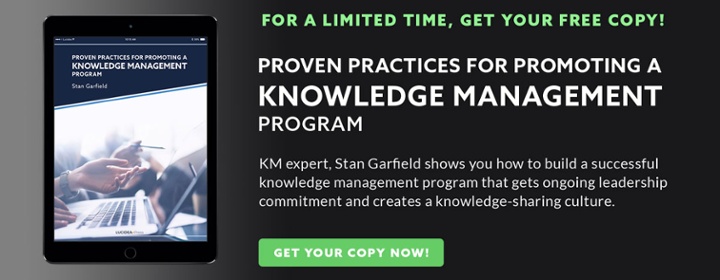
As you develop your knowledge management strategy, it’s important to get user input in order to determine which needs to address. Conduct surveys to identify challenges and needs, identify opportunities, and request suggestions.
Use an Opportunities Survey like the one below to determine business needs that can best be supported by knowledge management.
Determining what your users are struggling with, what they would like to see provided, and what they think should be done will help ensure your Top 3 Objectives are based on real imperatives.
Opportunities Survey
- Check all of the following challenges that you experience:
- It’s difficult for my team to make decisions, and when we make them, they are bad.
- It’s hard to find relevant information and resources at the time of need.
- We have to start from scratch each time we start a new project, and my team keeps reinventing the wheel.
- We repeat the same mistakes over and over.
- It’s difficult to find out if anyone else has solved a similar problem before, or has already done similar work.
- Information is poorly communicated to me, and I am unaware of what has been done, what is happening, and where the organization is heading.
- I can’t find standard processes, procedures, methods, tools, templates, techniques, and examples.
- I can’t get experts to help me, because they are scarce, in great demand, and unavailable when needed.
- We are unable to respond to customers who ask for proof that we know how to help them, and that we have done similar work before.
- It takes too long to invent, design, manufacture, sell, and deliver products and services to our customers.
- List any other challenges you regularly experience with sharing, innovating, reusing, collaborating, learning, and searching for knowledge.
- From the challenges you checked, and the ones you listed, please rank the three most important in decreasing order of importance:
- [fill in the most important challenge]
- [fill in the second most important challenge]
- [fill in the third most important challenge]
- What examples can you provide where sharing, innovating, reusing, collaborating, learning, and searching for knowledge are working well today?
- What examples can you provide where sharing, innovating, reusing, collaborating, learning, and searching for knowledge worked well in the past?
- What examples can you provide where sharing, innovating, reusing, collaborating, learning, and searching for knowledge at other organizations worked well in the past or are working well today?
- What suggestions do you have for dealing with any of the challenges you identified?
- What other needs do you have for sharing, innovating, reusing, collaborating, learning, and searching for knowledge?
- What suggestions do you have for meeting the needs you identified?
- Describe your ideal knowledge management environment and experience.
Challenges
After you conduct an Opportunities Survey, compile and review the results. Here some examples of challenges you may find.
- Bad decisions - poor decisions are made, it takes too long to make decisions, or it is impossible to make decisions. This results in lost business, missed opportunities, and reduced profits.
- Poor search capability - it's hard to find relevant information and resources when needed. As a result, people waste time searching, and 'can't take advantage of information which exists but 'can't be located.
- Reinventing the wheel - employees have to start from scratch each time they start a new project. This leads to wasted effort, increased costs, delays, and suboptimal results.
- Repetitive mistakes - the same mistakes are repeated over and over. This causes cost overruns, losses, and unhappy customers.
- Don't know what we know - it's difficult to find out if anyone in the organization knows something, has done something, or has solved a similar problem before. Potential advantages from reusing previous experience are squandered.
- Ignorance - information is communicated slowly, to a limited subset of the organization, or not at all. The result is that people are unaware of what has been done before, what is happening elsewhere, and where the organization is heading. This is not good for morale, customer satisfaction, or business results.
- Inadequate standards - there is a shortage of standard processes, procedures, methods, tools, templates, techniques, and examples. This results in inconsistency, sloppy work, and poor quality products and services.
- Expertise shortages - experts are hard to find, in great demand, and unavailable when needed. The effect is that scarce expertise is missed rather than leveraged, and knowledge which could have been applied to solve a problem or exploit an opportunity is not used.
- Poor reference capability - your organization is unable to respond to customers who ask for proof that you know how to help them and that you have done similar work before. This causes “winnable” bids to be lost.
- Long cycle times - it takes too long to invent, design, manufacture, sell, and deliver products and services to your customers. The impact is missed markets, delayed revenues, and customer attrition.
Opportunities
Use the results of the Opportunities Survey, the goals of your organization, and your knowledge of what other firms are doing to help compile a list of opportunities. Here are some that you may identify.
- Speed and agility – enable rapid decision making. This optimizes the use of resources, increases the win rate, and positively affects the state of the business.
- Findability – make it easy to find relevant information and resources. This takes advantage of available intelligence at the time of need.
- Effectiveness – take advantage of existing expertise and experience. If you know what you know, you can apply it appropriately.
- Learning – communicate important information widely and quickly. An informed work force can act in accordance with company strategy and direction.
- Repeatability – provide standard processes, procedures, methods, tools, templates, techniques, and examples. This results in consistent products and high quality services.
- Opportunism – make scarce expertise widely available. Applying key knowledge from one part of the organization when needed by another can make the crucial difference to winning a deal, satisfying a customer, or resolving a crisis.
- Efficiency – accelerate delivery to customers. The sooner the customer gets what they ordered, the sooner you will get the revenue—and the more likely they are to order again.
- Leverage – enable the organization to take advantage of its size. Being larger than your competition is not an advantage unless you take steps to exploit this fact. And it can be a disadvantage if it results in delays, suboptimal resource assignments, or inconsistent treatment. The benefits of large size include increased responsiveness, greater range of expertise, and better backup capabilities.
- Reliability – make the organization’s best problem-solving experiences reusable. The fact that someone has already solved a problem allows the same approach to be used the next time it arises. This speeds up resolution, reduces negative impacts, and keeps customers satisfied.
- Innovation – stimulate growth through invention, process improvement, cycle time reduction, and creative new ways of doing things. Benefits include market leadership, revenue growth, and improved brand equity.
Examples
From challenges and opportunities such as these, choose the ones that are most compelling to your organization and relate them to desired business results. Here are three sets of examples.
Non-Profit Organization
- Lower costs by preventing people from continually reinventing the wheel.
- Eliminate deficits caused by repeating the same mistakes.
- Increase contributions by innovating and creating new capabilities.
Manufacturing Company
- Increase orders through better collaboration between sales, services, and back-office functions.
- Increase revenue by stimulating a flow of ideas for new products and services.
- Increase profits by sharing and reusing lessons learned.
Consulting Firm
- Increase win rate by improving the proposal development process.
- Lower sales and delivery costs by reusing proven practices.
- Increase the quality of engagements by collaborating with customers and partners.
A KM program must respond to the fundamental needs of an organization. If it helps address those challenges and opportunities, it will succeed. If it is not tightly coupled to core business objectives, it will fail.
Lucidea Press has published my book, Proven Practices for Promoting a Knowledge Management Program, which includes advice, insights and real world examples of KM success drawn from my career as a KM practitioner.



